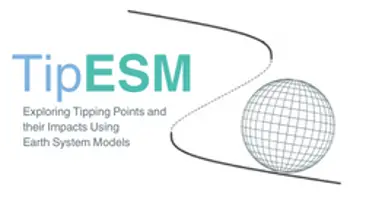TipESM
TipESM brings together scientists from a range of disciplines to deliver a step change in our understanding of climate tipping points in the Earth system, including their impact on ecosystems and society, combined with a set of early warning indicators and safe future emission pathways that minimise the risk of exceeding such tipping points.
TipESM assembles the latest Earth System Models (ESMs), including recent improvements to key processes: ice sheets, vegetation and land use, permafrost, marine and terrestrial biogeochemistry. In cooperation with the World Climate Research Programme (WCRP)/Future-Earth project TIPMIP, TipESM will organise an international collaboration to design and realise a common ESM experiment protocol that will facilitate analysis of the likelihood of occurrence, and potential reversibility, of tipping elements at different levels and duration of global warming. These experiments, will be combined with more project-specific ESM experiments, designed to investigate interactions and feedbacks across the Earth system. Based on the TipESM experiments, existing simulations and observations, we will investigate tipping points, their driving processes, potential early warning signals and cascading effects across the climate, ecosystems and society. Including the most important components of the Earth system in our ESMs will also allow TipESM to identify potentially unknown tipping elements, their precursors and impacts.
TipESM brings together expertise from climate science and climate impacts to investigate both the role of gradual climate change for tipping in individual ecosystems and society, and the impact of crossing specific climate tipping points for society, ecosystems, and biodiversity. Project findings will be synthesised into a tipping points risk register. New knowledge and data from TipESM will be regularly communicated to a broad range of research communities, policymakers and the public, contributing to a prepared and resilient society.

Project Goals
Using knowledge gained from latest ESM models and observational constraints, the primary objective of TipESM is to deliver a step change in our understanding of climate tipping points in the Earth system, including their impact on ecosystems and society, combined with a set of early warning indicators and safe emission pathways that minimise the risk of exceeding such tipping points.
TipESM will achieve its overarching objective through several specific objectives linked to the project work plan and its outcomes:
Specific objectives:
- To design and perform a set of coordinated experiments with coupled ESMs to support the investigation of Earth system tipping points at different levels of global warming.
- To identify climate tipping points in the CMIP6 archive and dedicated runs from TipESM and previous EU projects, and improve our understanding of the processes underpinning such TPs and their impacts across the Earth system.
- To investigate the robustness and potential (ir)reversibility of climate tipping points.
- To identify precursors of climate and ecological tipping points, and develop reliable early warning indicators based on ESM models and observations.
- To identify the risk of a cascade from one climate tipping event to others.
- To identify tipping events in ecological and societal systems, with a focus on the climate-drivers of these events, emphasising biodiversity, human health and habitability.
- To provide new understanding on the climate, societal and ecosystem consequences of crossing climate thresholds and tipping points.
- To deliver a risk register of future tipping points and a set of safe emission pathways to minimise the chance of crossing such tipping points.
- To provide policy guidance to the EC, IPCC, IPBES and the UNFCC Global Stocktake, on the likelihood and consequences of crossing climate tipping points and mitigation options to minimise the chance of such events.
About the project
Role of SMHI
SMHI is a partner in the project. Torben Koenigk is the project leader for SMHI.
Project partners
There are 15 project partners across Europe and the Danish Meteorological Institute (DMI) is the coordinator.
Funding
TipESM has received funding from the European Union’s Horizon Europe research and innovation programme through the call HORIZON-CL5-2023-D1-01-02 - Climate-related tipping points.
Timeline
The project starts January 2024 and finishes December 2027.
Climate tipping point: critical points in the climate system or in climate process, beyond which a significant and often unstoppable effect or change takes place.
Early warning signal/ indicators: indicator that a tipping point is close to be reached. A typical indicator is that the variability of the climate process that is close to tipping is changing, often a slow-down of the variability together with stronger amplitudes of the variability.
Cascades of tipping points: One process that is abruptly changing or tipping can trigger the tipping of another climate process or of an ecosystem. E.g. the melting of Greenland land ice can potentially trigger a collapse of the Gulfstream system which might further affect ecosystems in the North Atlantic.
